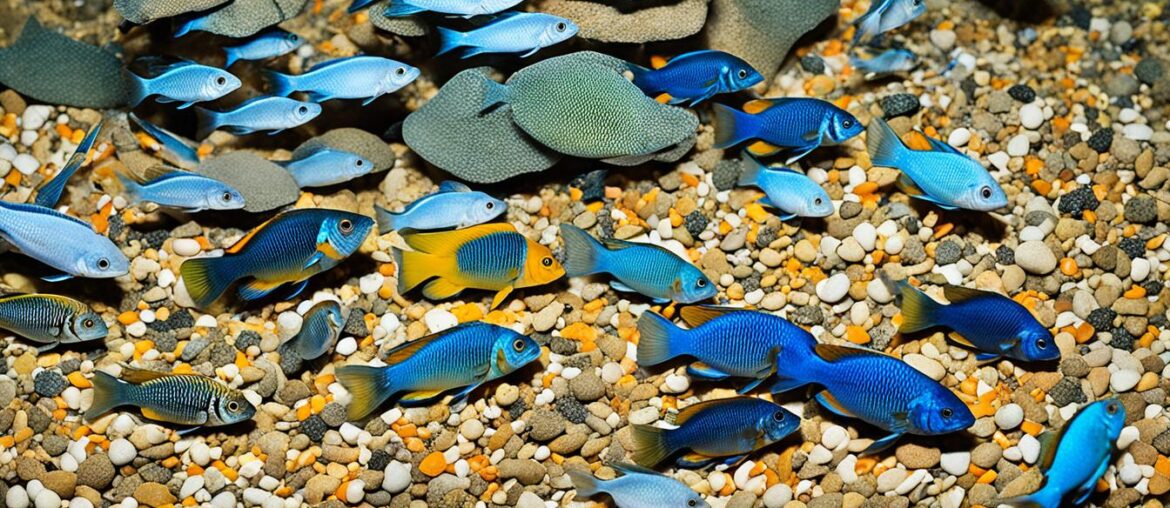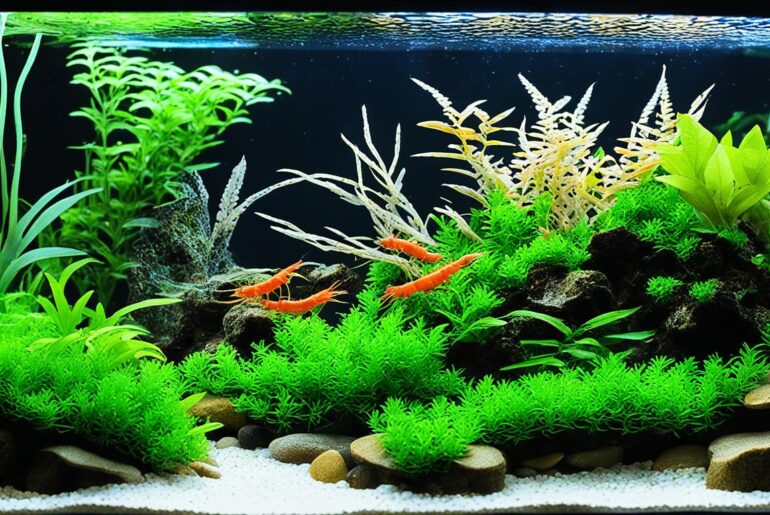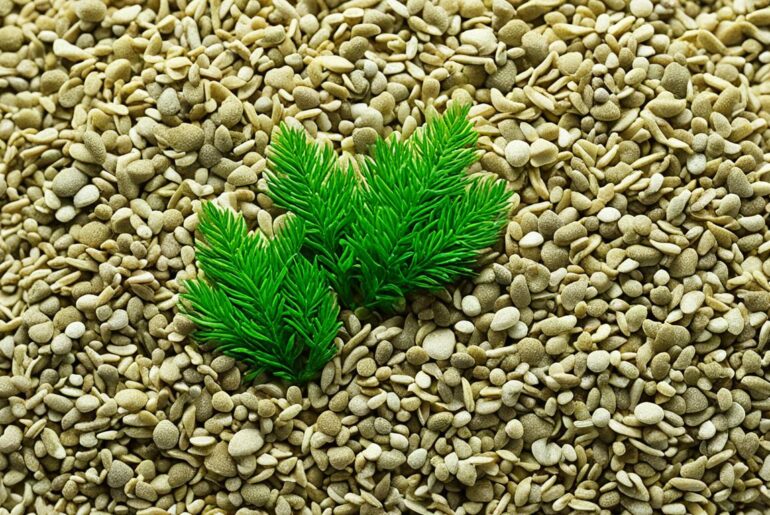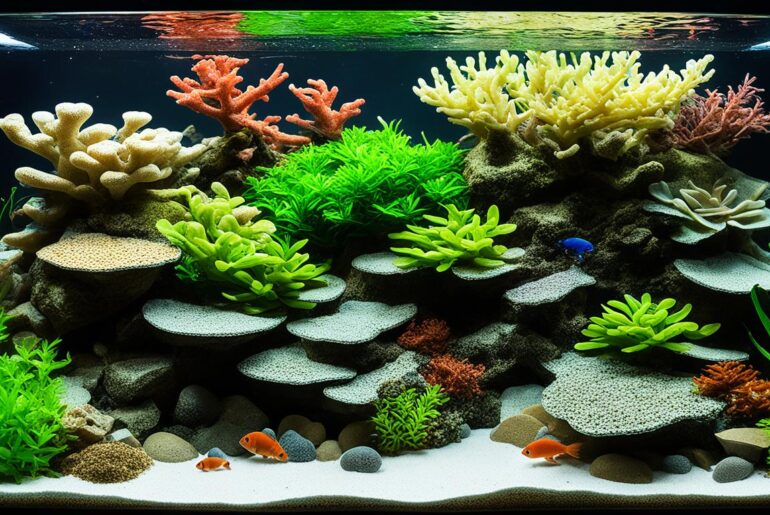As an avid fish enthusiast, I have spent countless hours creating the perfect home for my cichlids. From meticulously setting up their tank to carefully selecting the right decor, every detail mattered to me. But it wasn’t until I focused on choosing the right substrate that I truly saw a transformation in my cichlids’ behavior and overall well-being.
It started with my realization that cichlids have unique preferences and needs when it comes to their environment. They are natural diggers, constantly sifting through the substrate in search of food and territory. I wanted to provide them with a substrate that not only allowed them to exhibit their natural behavior but also created a healthy and visually appealing environment.
Choosing the right substrate for your cichlid tank is essential for the happiness and vitality of your fish. In this article, we will explore the key factors to consider, the different types of substrates available, popular choices, and the importance of maintaining the substrate. By the end, you will have all the knowledge you need to create a thriving and beautiful cichlid tank that your fish will adore.
Key Takeaways:
- Consider the preferences and needs of cichlids when choosing substrate.
- Ensure the substrate allows for natural digging behavior and is suitable for any live plants in the tank.
- Popular substrate choices include fine sand, gravel, crushed corals, and aragonite sand.
- CaribSea Aragonite Special Grade Sand and Pool filter sand are popular options.
- Maintain the substrate regularly to ensure the health of your fish and overall tank cleanliness.
Key Factors to Consider when Choosing a Substrate for Cichlid Tanks
Choosing the right substrate for your cichlid tank is crucial for creating a healthy and comfortable environment for your fish. There are several key factors that you should consider when selecting the best substrate for your cichlid aquarium.
1. Size and Texture:
The substrate should be fine enough for your cichlids to dig and sift through, allowing them to exhibit their natural behaviors. However, it should not be too small or lightweight that it gets easily blown away or trapped in the filter system. Furthermore, the substrate should be smooth to prevent any injuries to the sensitive mouth and barbels of your fish.
2. Support for Live Plants:
If you plan to have live plants in your cichlid tank, it’s important to choose a substrate that can support their growth. Consider using a substrate that provides nutrients to the plants and allows their roots to anchor securely.
3. Stability for Decorations:
The substrate should provide a stable base for any decorations you plan to add to your cichlid tank. This will prevent them from toppling over and potentially causing harm to your fish. Look for a substrate that can hold decorations firmly in place.
4. Aesthetics:
The appearance of your cichlid tank is also an important factor to consider. Choose a substrate that complements the overall design and theme of your aquarium. You can opt for natural-looking substrates, such as sand or gravel, or explore different colors and textures to add visual interest.
By considering these key factors, you can select the best substrate for your cichlid tank that meets the needs of your fish and enhances the overall beauty of your aquarium.
Types of Substrates Suitable for Cichlid Tanks
Choosing the right substrate for your cichlid tank is crucial to create a comfortable and natural environment for your fish. There are several types of substrates that are suitable for cichlid tanks, each offering unique benefits. Let’s explore some options:
Fine Sand
Fine sand is a popular choice for cichlid tanks as it closely mimics their natural environment. This substrate allows cichlids to exhibit their natural digging behavior, which is essential for their well-being. It also provides a soft and gentle surface for the fish, preventing any injuries to their sensitive mouths and barbels.
Gravel
Gravel is another option for cichlid tank substrate. However, it is important to choose smooth gravel that is not too large to avoid any harm to the fish. Gravel provides a stable base for decorations and plants, allowing you to create a visually appealing tank layout.
Crushed Corals and Aragonite Sand
For those looking to maintain specific water parameters in their cichlid tank, crushed corals and aragonite sand are excellent choices. These substrates help buffer the water pH and maintain water hardness, creating a stable and optimal environment for your cichlids.
When selecting a substrate for your cichlid tank, consider the specific needs and preferences of your fish. Fine sand is recommended for those wanting to recreate a natural setting, while gravel and crushed corals are ideal for those seeking specific water parameter control. Whichever substrate you choose, ensure it aligns with the well-being of your cichlids and enhances the overall aesthetics of your tank.
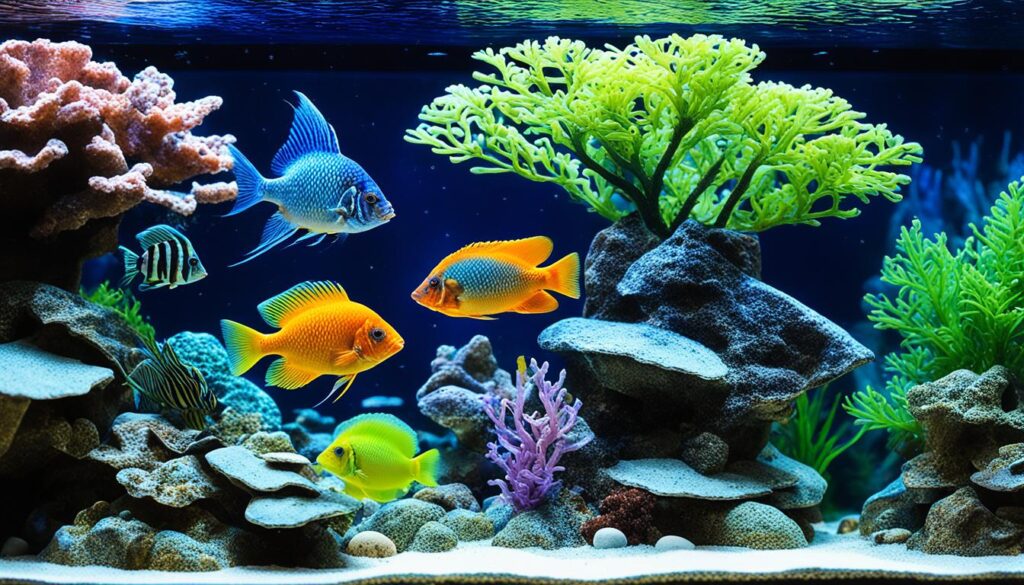
In the next section, we will explore popular substrate choices for cichlid tanks and discuss their advantages and disadvantages. Stay tuned!
Popular Substrate Choices for Cichlid Tanks
When it comes to choosing the right substrate for your cichlid tank, there are several popular options to consider. These substrates not only provide a suitable base for your tank but also offer additional benefits for your fish’s health and the overall aesthetics of the aquarium.
CaribSea Aragonite Special Grade Sand
One popular choice among cichlid tank enthusiasts is the CaribSea Aragonite Special Grade Sand. This substrate has the ideal size for cichlids, allowing them to comfortably dig and sift through the sand. Additionally, it helps buffer the pH levels of the water, creating a more stable and optimal environment for your fish.
Pool Filter Sand
Another widely used substrate is pool filter sand. This option is not only affordable but also easy to maintain. The fine texture of the sand provides a comfortable surface for your cichlids to dig and explore. Pool filter sand can be an excellent choice for both beginners and experienced fishkeepers looking for a practical and cost-effective substrate solution.
CaribSea Ivory Coast Sand
If you’re looking for a substrate that adds a natural-looking color to your cichlid tank, CaribSea Ivory Coast Sand is a great option. This sand not only enhances the visual appeal of your aquarium but also contains natural buffers that contribute to the overall water quality. The combination of aesthetics and functionality makes it a popular choice among cichlid tank owners.
Nature’s Oceans African Cichlid Substrate
For those concerned about biofouling and water filtration, Nature’s Oceans African Cichlid Substrate is worth considering. This substrate helps prevent the accumulation of waste and debris, reducing the risk of water contamination. With its effective filtration properties, it promotes cleaner and healthier water conditions for your cichlids.
Choosing the right substrate for your cichlid tank is crucial for creating a suitable and visually appealing environment for your fish. Whether you opt for CaribSea Aragonite Special Grade Sand, pool filter sand, CaribSea Ivory Coast Sand, or Nature’s Oceans African Cichlid Substrate, each option offers unique benefits that contribute to the overall well-being of your cichlids.
Pros and Cons of Different Substrate Options for Cichlid Tanks
When it comes to choosing the right substrate for your cichlid tank, it’s important to weigh the pros and cons of each option. Each substrate has its own unique characteristics that can impact the overall health and well-being of your fish. Let’s take a closer look at some popular substrate choices and their advantages and disadvantages:
Fine Sand
Pros:
- Allows cichlids to exhibit their natural digging behavior
- Mimics their natural environment
Cons:
- May be easily blown by filters
Gravel
Pros:
- Provides a stable base for decorations
Cons:
- Should be smooth to prevent injuries to the fish
CaribSea Aragonite Special Grade Sand
Pros:
- Helps buffer the pH
Cons:
- May contain some black grains
Pool Filter Sand
Pros:
- Affordable option
Cons:
- Requires careful selection to ensure the grains are not too small
When choosing the substrate for your cichlid tank, consider these pros and cons to determine which option best suits your needs. It’s important to provide a substrate that not only supports the natural behavior of your cichlids but also contributes to the overall health and aesthetics of the tank.
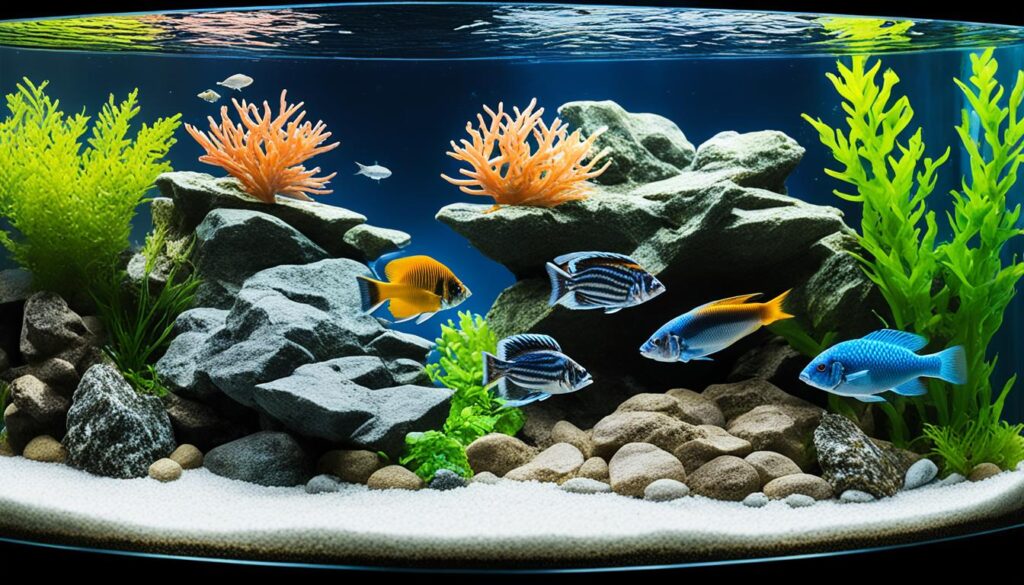
Keep in mind that maintaining the substrate is also vital for the well-being of your fish. Regular cleaning and monitoring of water parameters will help ensure a thriving and vibrant cichlid tank.
Considerations for Water Parameters in Cichlid Tanks
When it comes to keeping cichlids, understanding and maintaining the right water parameters is crucial. The chosen substrate should not only provide a suitable environment for the fish but also support their specific water parameter requirements. Let’s take a closer look at the considerations for water parameters in cichlid tanks.
One example of cichlids with specific water parameter needs is African cichlids. These fish typically have a high mineral content and prefer alkaline water with a pH range of 7.7 to 9.3. Therefore, the substrate chosen for an African cichlid tank should be able to maintain these alkaline water parameters and provide the necessary minerals for the fish’s health and well-being.
Choosing the right substrate not only contributes to the overall aesthetic of the tank but also plays a vital role in maintaining a stable environment for the cichlids. The table below provides an overview of the ideal water parameters for various cichlid species:
| Cichlid Species | pH Range | Water Hardness | Temperature Range (°F) |
|---|---|---|---|
| African Cichlids | 7.7 – 9.3 | 10 – 20 dGH | 74 – 82 |
| South American Cichlids | 6 – 7.5 | 4 – 10 dGH | 72 – 78 |
| Central American Cichlids | 7.5 – 8.5 | 6 – 12 dGH | 75 – 82 |
It is important to research the specific water parameter requirements of the cichlid species you plan to keep and choose a substrate that can support those requirements. Maintaining the correct water parameters will help ensure the long-term health and vitality of your cichlids.
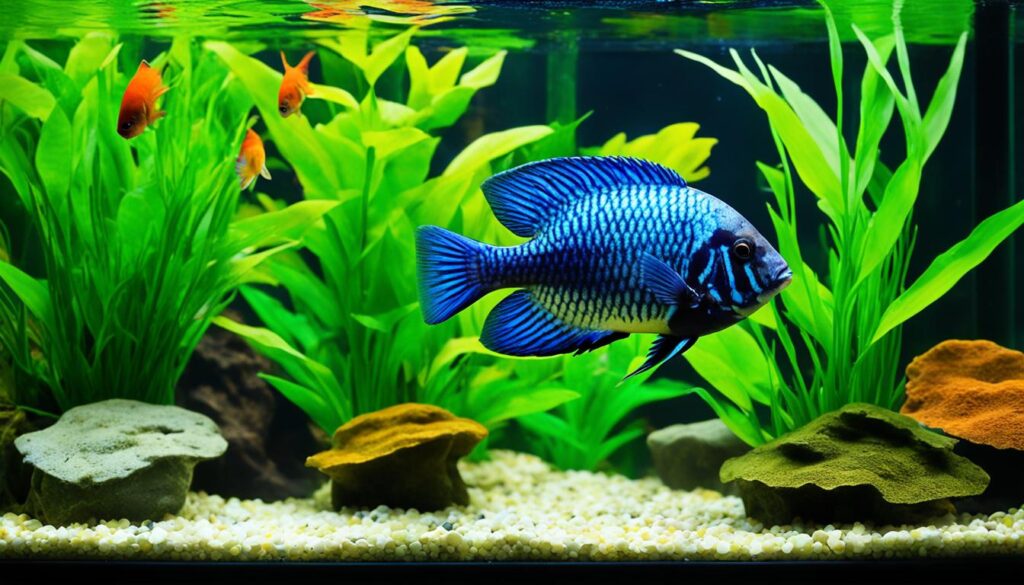
Using Substrate to Enhance the Aesthetics of Your Cichlid Tank
The substrate chosen for your cichlid tank can greatly enhance the overall aesthetics of the tank. By carefully selecting the right substrate, you can create a visually appealing environment that mimics the natural habitat of the cichlids.
Consider the natural environment where the cichlids originate from. Are they found in sandy bottoms or rocky areas? Use this information as a guide to choose a substrate that closely resembles their natural habitat. For cichlids that prefer sandy environments, opt for a fine sand substrate that allows them to exhibit their natural digging behavior. If your cichlids prefer rocky areas, choose a substrate that replicates these rocky structures.
Another way to enhance the aesthetics of your cichlid tank is by using different colors and textures of substrate. You can mix different colored sands or gravels to create interesting patterns and designs in the tank. This adds visual interest and makes your tank stand out.
Quote:
“The right substrate can transform a cichlid tank from a simple aquarium into a captivating piece of living art.”
– Expert Aquarist, Jane Wilson
In addition to enhancing the aesthetics, the substrate can also serve as a base for decorations and plants in your cichlid tank. Use rocks, driftwood, or artificial plants to create a natural-looking underwater landscape. These decorations not only provide hiding spots and territories for your cichlids but also add depth and dimension to the overall design of the tank.
Remember to arrange the decorations and plants strategically to create visually appealing focal points within the tank. Consider the different heights, colors, and textures to create a balanced and harmonious layout.
Overall, the substrate you choose for your cichlid tank plays a key role in enhancing the aesthetics of the tank. By selecting a substrate that mimics the natural habitat, using different colors and textures, and incorporating decorations and plants, you can create a visually stunning and captivating cichlid tank.
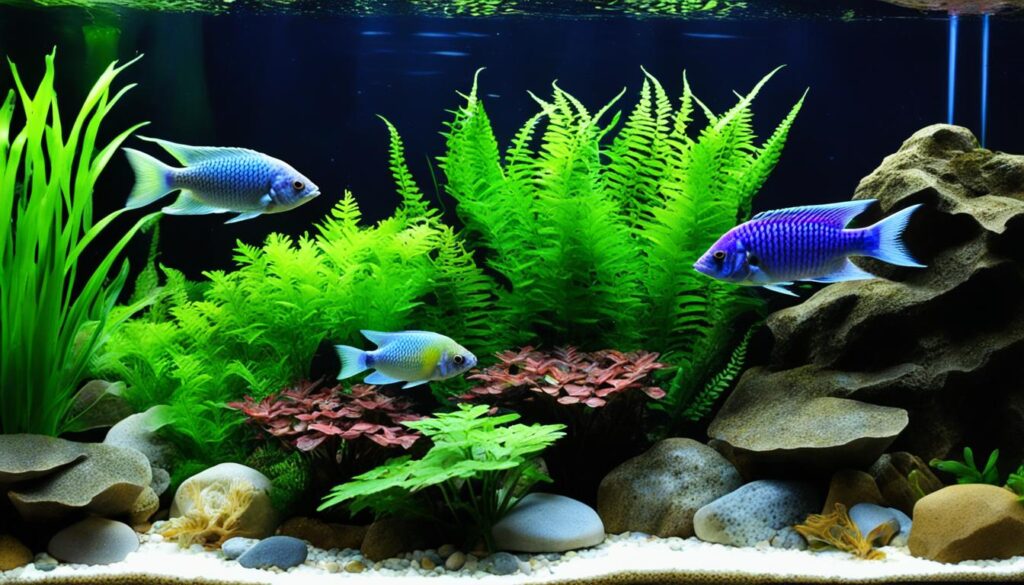
Popular Substrate Choices for Cichlid Tanks
| Substrate Choice | Description |
|---|---|
| CaribSea Aragonite Special Grade Sand | Finely grained sand that buffers pH |
| Pool Filter Sand | Affordable option for cichlid tanks |
| CaribSea Ivory Coast Sand | Natural-looking sand with water buffering properties |
| Nature’s Oceans African Cichlid Substrate | Prevents biofouling and aids in water filtration |
Proper Substrate Maintenance for Cichlid Tanks
Proper maintenance of the substrate in your cichlid tank is crucial to ensure the health and well-being of your fish. Regular cleaning of the substrate is necessary to remove any debris or waste that may accumulate. This will help maintain water quality and create a clean environment for your cichlids to thrive.
One effective way to clean the substrate is by gently vacuuming it during water changes. The vacuum will help remove any uneaten food, fish waste, and other organic matter that may have settled on the substrate. Simply hover the vacuum over the substrate, allowing it to suck up the debris without disturbing the substrate bed.
It is important to monitor the water parameters regularly to ensure the substrate remains in optimal condition. Test for any imbalances that may affect the substrate and the overall health of the tank. Maintaining proper pH, ammonia, nitrite, and nitrate levels will help prevent any issues that could harm your cichlids or impact the substrate.
Additionally, consider incorporating beneficial bacteria into your cichlid tank. These bacteria help break down organic waste, reducing the risk of debris buildup in the substrate. Using a bacterial supplement or seeding the substrate with beneficial bacteria can contribute to a healthier tank environment.
Lastly, be cautious when introducing new decorations or plants to your cichlid tank. Inspect them thoroughly to remove any excess dirt or debris that may contaminate the substrate. This will prevent potential issues and maintain a clean and aesthetically pleasing substrate bed.
Regular maintenance and cleaning of the substrate in your cichlid tank will not only ensure the longevity of the tank but also contribute to the overall well-being of your fish. By keeping the substrate clean and the water parameters in check, you can provide a healthy and comfortable home for your cichlids to thrive.
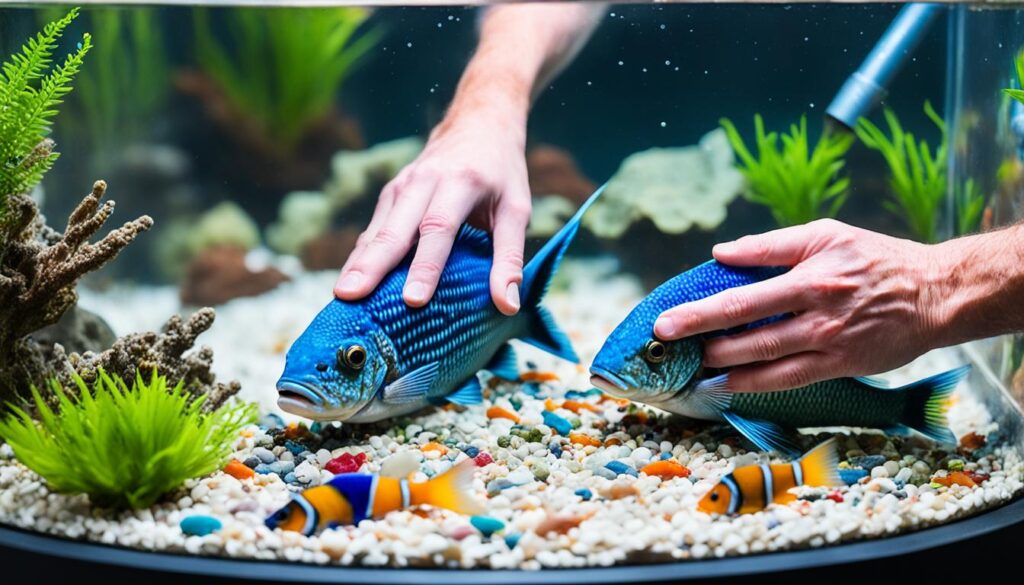
| Substrate Maintenance Tips for Cichlid Tanks |
|---|
| Regularly clean the substrate by gently vacuuming during water changes. |
| Monitor water parameters to ensure optimal substrate conditions. |
| Consider adding beneficial bacteria to promote a healthier tank environment. |
| Inspect new decorations and plants to remove any excess dirt or debris. |
Conclusion
Choosing the right substrate for your cichlid tank is crucial for creating a vibrant and healthy environment for your fish. By considering the preferences and needs of your cichlids, the necessary water parameters, and the overall aesthetics of the tank, you can provide a comfortable and visually appealing home for your aquatic companions.
The substrate you choose plays a significant role in simulating the natural behavior of cichlids. Fine sand, such as CaribSea Aragonite Special Grade Sand, allows them to dig and sift through their environment, mimicking their natural habitat. Additionally, gravel and crushed corals can offer stability for tank decorations and contribute to maintaining the water pH and hardness.
Remember to regularly maintain the substrate of your cichlid tank. This involves gentle vacuuming during water changes to remove debris and waste that may accumulate. Monitoring and testing the water parameters ensure the longevity of the substrate and promote the overall health of your cichlids.
With the right substrate, you can create an optimal environment that satisfies your cichlids’ natural behaviors, supports their well-being, and enhances the beauty of your tank. Take the time to research and choose the substrate that best suits your cichlid species, and enjoy the rewards of a thriving and visually captivating aquarium.
FAQ
What factors should I consider when choosing a substrate for my cichlid tank?
When choosing a substrate for your cichlid tank, you should consider the natural behavior of the fish, the need for a healthy environment, and the overall aesthetics of the tank.
What is the best substrate for cichlids?
The best substrate for cichlids should be fine enough for them to dig and sift through, smooth enough to prevent injuries, and able to support live plants and decorations.
What are the types of substrates suitable for cichlid tanks?
Some suitable substrates for cichlid tanks include fine sand, smooth gravel, crushed corals, and aragonite sand.
What are some popular substrate choices for cichlid tanks?
Some popular substrate choices for cichlid tanks include CaribSea Aragonite Special Grade Sand, pool filter sand, CaribSea Ivory Coast Sand, and Nature’s Oceans African Cichlid Substrate.
What are the pros and cons of different substrate options for cichlid tanks?
Fine sand allows cichlids to exhibit their natural digging behavior but may be easily blown by filters. Gravel provides a stable base for decorations but should be smooth to prevent injuries. Aragonite sand helps buffer the pH but may contain some black grains. Pool filter sand is affordable but requires careful selection. Each option has its own advantages and disadvantages.
What considerations should I have for water parameters in cichlid tanks?
The substrate chosen should be able to support the specific water parameter requirements of the cichlids, such as pH and water hardness.
How can I use substrate to enhance the aesthetics of my cichlid tank?
You can choose a substrate that mimics the natural habitat of the cichlids and use different colors and textures to create interesting patterns. It can also be used as a base for decorations and plants.
How should I properly maintain the substrate in my cichlid tank?
Regular cleaning of the substrate is necessary to remove debris or waste, which can be done by gently vacuuming during water changes. It is also important to monitor water parameters and test for any imbalances that may affect the substrate and the overall health of the tank.
